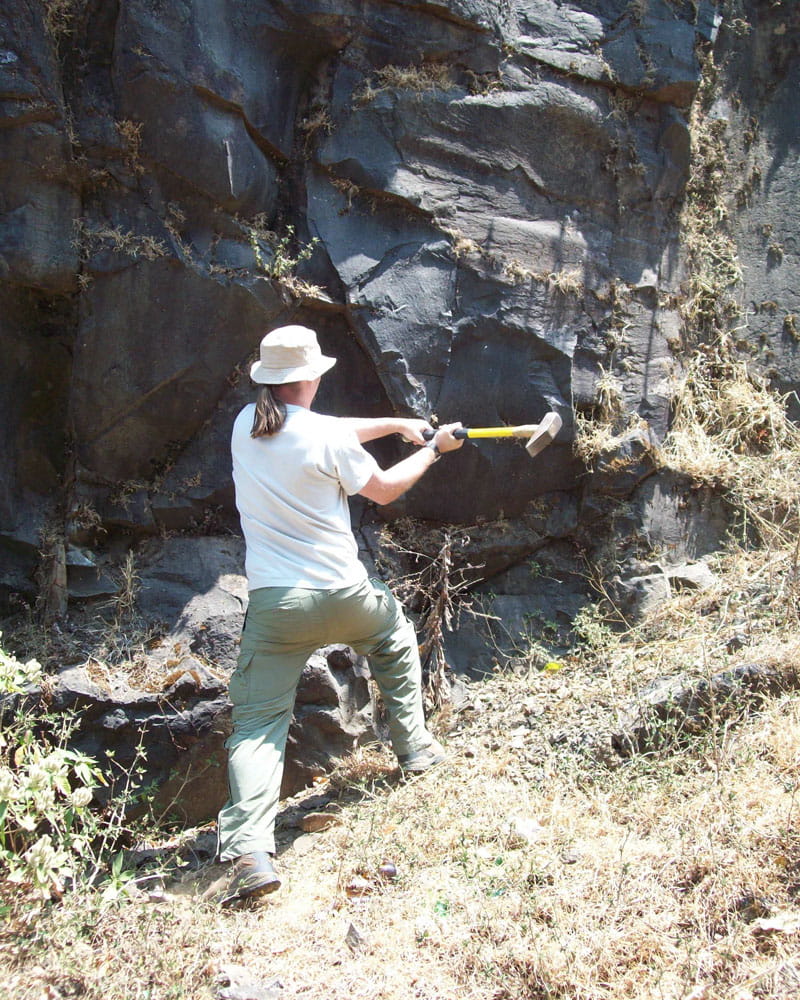Did Asteroid Impact or Volcanic Eruption Kill the Dinosaurs? Probably Both, Says New Study

- Mosquitoes' Bloodsucking Tubes Could Enable High-Definition 3D Printing
- Drexel Selects New, World-Class Life Sciences Building at 3201 Cuthbert Street for Medical Research Operations
- Breakthrough on Gene Therapy for Hereditary Spastic Paraplegia
- Drexel Environmental Collaboratory Releases Cross-Sector Findings on Severe Weather Recovery Challenges

Was it an asteroid impact on Earth 66 million years ago that wiped out the dinosaurs? Or the eruption of volcanoes in India for hundreds of thousands of years? For decades, paleontologists and geologists have debated the role these two global events played in the last mass extinction.
But compelling new evidence supports the hypothesis of a group of geoscientists: that the asteroid’s impact ignited volcanoes around the globe, most catastrophically in India, and that, together, these planet-wide catastrophes caused the extinction of many land and marine animals, including the dinosaurs.

Drexel University volcanologist Loÿc Vanderkluysen, PhD, was among the group of researchers, primarily from the University of California, Berkeley, that made the discovery, which will be published in the Oct. 2 issue of the journal Science.
The new evidence includes the most accurate dates yet for the volcanic eruptions before and after the impact of the Chicxulub asteroid off the coast of the Yucatan Peninsula in Mexico. The new dates show that the lava flows from one of the largest volcanic features on Earth, the Deccan Traps in India, which at the time were erupting at a slower pace, doubled in output within 50,000 years of the impact that is thought to have initiated the mass extinction.
“To give a sense of scale of the Deccan Traps, the longest lava flow observed by humans is about 30 miles long,” said Vanderkluysen. “In the Deccan, the lava flows are 20 times longer and reach 600 miles. That’d be enough for lava to flow out of Philly and reach Cincinnati. The Deccan province today would be large enough to cover the whole state of California with lava flows, stacked a mile high.”
The geologists argue that the impact abruptly changed the volcanoes’ plumbing system, which produced major changes in the chemistry and frequency of the eruptions. Both the impact and the volcanism would have blanketed the planet with dust and noxious fumes, drastically changing the climate and causing many species to expire before their time.
“This study shows without a doubt that a huge amount of magma was emplaced at the surface of the Earth in a really short amount of time – approximately 700,000 years,” said Vanderkluysen. “For a geologist, that’s truly spectacular.”
The environmental impacts of such gigantic volcanic eruptions greatly depend on how fast volcanic gases are released to the atmosphere, according to Vanderkluysen. If the gases are released in a short amount of time, as in a quick sequence of many large eruptions, then the atmosphere may not have time to fully recover between each eruption, and the effect of these gases can become cumulative.
“This opens the possibility that the mass extinction that wiped out the earth of non-avian dinosaurs, ammonites and so many other life forms, was a result of a double-whammy of large volcanic eruptions and a large asteroid impact happening simultaneously,” said Vanderkluysen.
While the data don’t conclusively prove that the impact caused these changes, the connection looks increasingly clear, according to the researchers.
Vanderkluysen, an assistant professor in the Department of Biodiversity, Earth & Environmental Science in Drexel’s College of Arts and Sciences, has been working on this volcanic province in India for more than a decade.
The team’s first trip to India in 2005 led to the discovery that there was a major transition in the style of volcanism during the eruptions of the Deccan Traps lava flows. At some point, the lava flows become even larger, changed chemical composition and are separated by longer time intervals. “All these signs pointed to the fact that the magma system that was feeding these very large volcanic eruptions in India was suddenly disturbed,” he said.
“Our previous research presented the hypothesis that a large asteroid impact off the coast of Yucatan could have shaken the Earth globally, which could have disrupted the magmatic systems of volcanoes across the world, causing this transition,” said Vanderkluysen. “However, this hypothesis remained very much untested and controversial.”
The Science study tests a critical point of the hypothesis: can it be demonstrated that the volcanic transition in India actually happened at the same time as the Chicxulub? This question was previously very difficult to answer due to the insufficient quality of the methods of dating rocks, which provided a resolution of only +/- 1 million years.
However, this study provides new dates on lava flows from the Deccan with very high precision, better than 100,000 years (and in some cases, only +/- 50,000 years), improving the quality of the age data 10-fold. “The new data are fully compatible with our hypothesis and show that the impact and the transition happened within ~50,000 years of each other, which is within the error of our measurements, and essentially the blink of an eye on a geological time scale,” said Vanderkluysen.
Vanderkluysen’s role was to put the samples into their geological and volcanic context. While the study’s lead authors did the analytical work to obtain accurate dates, Vanderkluysen made sure the samples were the right samples from the right place. “The Deccan is a very large place, roughly the size of Spain, and it’s easy to lose track of your objectives in its immensity,” he said.
Vanderkluysen will return to India in December 2015 and March 2016, as the team plans to obtain isotope dates for more volcanic rock samples from the Deccan Traps to detail the history of the lava flows that cover much of western India, in order to understand better how they changed with time and correlate to the impact and extinctions
In This Article
Contact
Drexel News is produced by
University Marketing and Communications.